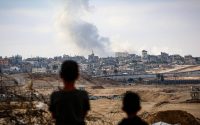Jenin Has a Long Legacy as a Bastion of Palestinian Armed Struggle
As Israeli forces hunted for wanted men, weapons and explosives in the Palestinian refugee camp in Jenin this week, after using aerial drones to blow up what they described as terrorist hubs there, the city was living up to its reputation as a center of militant defiance in the occupied West Bank.
To many Israelis, the city and its environs are a dreaded incubator of terrorism that has claimed many lives over the years. During the second Palestinian intifada, or uprising, the Jenin refugee camp was a prime exporter of suicide bombers to Israeli cities. Israeli officials say that more than 50 shooting attacks on Israelis have emanated from the Jenin area this year, and that 19 militants have taken refuge in the camp after carrying out attacks since last fall.
To many Palestinians, Jenin, in the hilly northern reaches of the West Bank, is a heroic symbol of resilience and resistance against Israeli rule, and the rule of others who came before. That reputation was sealed in 2002, at the height of the second intifada, when the camp was the scene of a fierce, 10-day battle in which 52 Palestinians, around half of whom may have been civilians, according to the United Nations, and 23 Israeli soldiers were killed.
Yasir Arafat, the late Palestinian leader, coined a new name for the camp that year: “Jeningrad,” comparing it to the World War II battle of Stalingrad.
On Monday and Tuesday, hundreds of Israeli commandos took part in the largest military incursion in many years in the area, scouring the crowded camp and killing at least 12 people. The military says it has discovered laboratories for manufacturing explosives and caches of weapons and explosive devices hidden inside buildings, under the narrow roads and even in pits underneath a mosque.
A spokesman for the Israeli Defense Forces also said on Twitter that a soldier had been killed “by gunfire” during the military operation.
Israel’s military said on Wednesday that it had withdrawn from Jenin. But given the history, analysts say, it may not be long before Israeli troops are back.
“Jenin is revered because it has provided the Palestinian collective memory with many examples of not just resistance but also of popular endorsement and solidarity,” said Nour Odeh, a Palestinian columnist and political analyst based in Ramallah. “It’s not a rich or industrial city,” she added, but a place with “a sense of common destiny and unity” where normally competing armed factions of a deeply divided Palestinian society and polity fight as one.
Jenin was the northernmost of 19 West Bank sites originally established to house some of the hundreds of thousands of Palestinians who fled or were forced from their homes in what is now Israel in the late 1940s — when the state of Israel was established and its Arab neighbors waged an unsuccessful war to crush it — and have never been allowed to return. The sites are still referred to as camps, but have become built-up towns or neighborhoods, though with generally substandard conditions.
In the Jenin camp, as many as 17,000 residents are crowded into an area of less than half a square mile, abutting the city of Jenin with about 40,000 people and just three miles from the line separating Israel from the West Bank. The United Nations says the camp has not only been plagued by violence, but has “one of the highest rates of unemployment and poverty” in the West Bank.
In a year of escalating violence in the area, Israel has mounted frequent raids into Jenin to arrest Palestinians suspected of planning or carrying out attacks against Israelis. Many have turned deadly after setting off prolonged gun battles between troops and armed militants.
Jenin has become a bastion in the West Bank of Hamas, the Islamic militant group that controls the Palestinian coastal enclave of Gaza, and of Islamic Jihad. Newer, unaffiliated militias have sprung up, made up of a new generation of gunmen, some of them born after the second intifada ended in 2005, who act on their own initiative and do not answer to the established organizations.
Of the Palestinians killed, according to the Palestinian Ministry of Health, by Israeli fire in the camp since early Monday, at least five have been claimed as fighters by militant groups, including a boy of 16. Israel says all those killed so far were combatants, though the affiliations of the others remained unclear.
Israel’s right-wing government has sworn to take tougher action against Palestinian violence, while the Palestinian Authority, which is generally weak and unpopular, has all but abandoned policing the hotbeds of militancy in the northern West Bank, signaling a loss of control and adding to the atmosphere of lawlessness.
“Jenin is basically a countryside, rural town,” said Ehud Yaari, an Israel-based fellow of the Washington Institute for Near East Policy and co-author of the book “Intifada” about the first Palestinian uprising from 1987 to 1993, describing the city as “a kind of backwater.” It is off the beaten track for most Palestinians, and far from Ramallah, the seat of the Palestinian Authority, the body created in the 1990s that exercises limited self-rule over parts of the West Bank.
Years of neglect by the Palestinian Authority made Jenin an easy recruiting ground for the authority’s rivals in Hamas and Islamic Jihad, Mr. Yaari said, adding that those groups have recently flooded the area with weapons and money provided by their Iranian backers.
During the second intifada, according to Israeli estimates, at least 28 suicide bombers set out from the Jenin camp.
Palestinian officials tried to cast the Israeli assault of 2002, part of a larger offensive in the West Bank, as a “massacre” with hundreds of Palestinian fatalities in the camp, a claim that the United Nations examined and rejected. But the legacy stuck.
Even before Israel existed as a state, Jenin became known as a center of rebellion in the late 1930s, during the Arab revolt against British rule and against Jewish immigration to Palestine. A British official was assassinated in his office in Jenin and in a reprisal attack, British forces blew up a quarter of the town.
After the first Arab-Israeli war in 1948-49, the West Bank came under Jordanian control. Then Israel captured it in the 1967 war and Jordan later renounced its claim to the territory. The Palestinian Authority nominally took over Jenin and other parts of the West Bank in the mid-1990s.
In 2005, hoping to reduce friction in the area and signal progress toward a resolution of the Israeli-Palestinian conflict, Israel dismantled four Jewish settlements around Jenin, the same year that it withdrew from the Gaza Strip. Jenin and the northern West Bank were then viewed by Israeli, Palestinian and international authorities as a kind of pilot program for Israeli disengagement from the occupied territory, and by some even as a potential prototype for a future Palestinian state. That model has since collapsed.
Israelis would routinely traverse the boundary to Jenin for shopping, car repairs and dental care, but that has become more dangerous. Israel has restricted checkpoint crossings by Palestinians, so fewer of them enter Israel daily for work, according to the United Nations.
Israel has stepped up construction in Jewish settlements in the West Bank, a major point of friction. Palestinian gunmen often shoot at Israeli communities across the line.
And proximity to the boundary has another meaning for the Palestinian refugees in the Jenin camp, Ms. Odeh, the political analyst in Ramallah, said.
“The refugees there can literally look out the window and see where their fathers and grandparents were displaced from,” she said.


